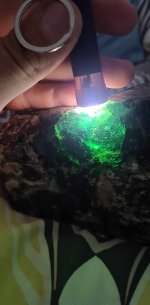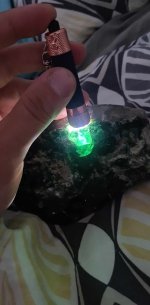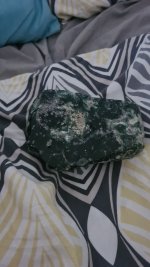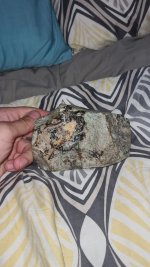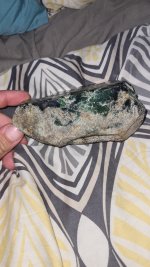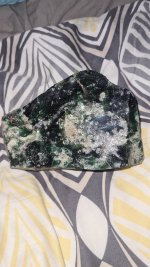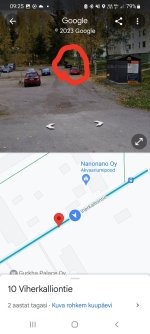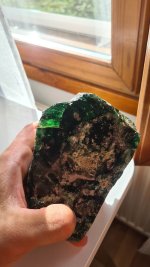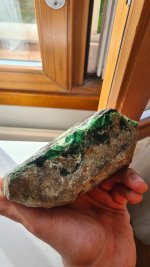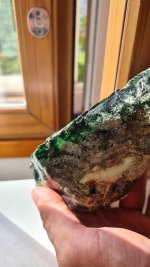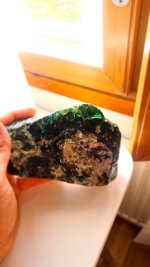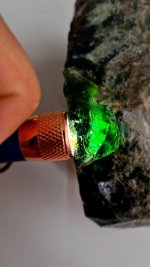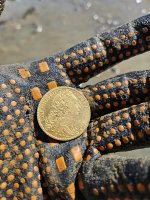What kind of rock can this be? One gem inspector told me it was moldavite but maybe it is something more, haven't seen this kind of rock anywhere...
Navigation
Install the app
How to install the app on iOS
Follow along with the video below to see how to install our site as a web app on your home screen.
Note: This feature may not be available in some browsers.
More options
You are using an out of date browser. It may not display this or other websites correctly.
You should upgrade or use an alternative browser.
You should upgrade or use an alternative browser.
🔎 UNIDENTIFIED Need help with this meteorite, moldavite ?
- Thread starter Raido181
- Start date
Red-Coat
Gold Member
Welcome to Tnet.
It's not moldavite, which is a glass that formed at high temperature and consequently doesn't occur in crystalline masses. It's amorphous. Also (although you didn't say where you found it) moldavite only occurs in certain localities in Europe (principally in the Czech Republic), having been ejected from the Nördlinger Ries Crater in southern Germany.
Although there are other possibilities, I would guess that the green material is olivine, if found in an area where there are volcanic rocks. There also appears to a secondary mineral with an acicular (needle-like) crystal habit. Again there are multiple possibilities but quartz could be ruled out if the green material is olivine because they don't occur together.
Not much more could be said from pictures alone.
It's not moldavite, which is a glass that formed at high temperature and consequently doesn't occur in crystalline masses. It's amorphous. Also (although you didn't say where you found it) moldavite only occurs in certain localities in Europe (principally in the Czech Republic), having been ejected from the Nördlinger Ries Crater in southern Germany.
Although there are other possibilities, I would guess that the green material is olivine, if found in an area where there are volcanic rocks. There also appears to a secondary mineral with an acicular (needle-like) crystal habit. Again there are multiple possibilities but quartz could be ruled out if the green material is olivine because they don't occur together.
Not much more could be said from pictures alone.
Upvote
4
- Thread starter
- #3
Well I found it in helsinki,finland, in front of a apartment house. It was sticking out in dirt, at first tought it was glass bottle as i didnt want to drive over it. Then dug it up and it was that.Welcome to Tnet.
It's not moldavite, which is a glass that formed at high temperature and consequently doesn't occur in crystalline masses. It's amorphous. Also (although you didn't say where you found it) moldavite only occurs in certain localities in Europe (principally in the Czech Republic), having been ejected from the Nördlinger Ries Crater in southern Germany.
Although there are other possibilities, I would guess that the green material is olivine, if found in an area where there are volcanic rocks. There also appears to a secondary mineral with an acicular (needle-like) crystal habit. Again there are multiple possibilities but quartz could be ruled out if the green material is olivine because they don't occur together.
Not much more could be said from pictures alone.
Upvote
0
It's a man made product - industrial slag "glass". The crystals are common when certain minerals are present in the mix.
More than likely from the appearance I would guess the main composition to be silica , fluorite, limestone and feldspar. The Fluorite and feldspar are for flux and the silica could have been from the ore or from added sand. The limestone is added to control the pH of the final product, the silica keeps the smelted metal from being too thick to pour evenly and the fluxes lower the melting point of the mix.
The bulk of the slag is scraped off the top of the smellted metal before it's poured. Crystals usually form when the feldspar and calcite (from the limestone) cool in the presence of moisture. Other minerals and fluxes could well be involved.
I'd guess the source is Outokumpu? The copper/nickle smelters there would probably produce a slag very much in this color range.
Definitely not Olivine Red-Coat. The clear gem variety of Olivine is Peridot which is never deep green.
More than likely from the appearance I would guess the main composition to be silica , fluorite, limestone and feldspar. The Fluorite and feldspar are for flux and the silica could have been from the ore or from added sand. The limestone is added to control the pH of the final product, the silica keeps the smelted metal from being too thick to pour evenly and the fluxes lower the melting point of the mix.
The bulk of the slag is scraped off the top of the smellted metal before it's poured. Crystals usually form when the feldspar and calcite (from the limestone) cool in the presence of moisture. Other minerals and fluxes could well be involved.
I'd guess the source is Outokumpu? The copper/nickle smelters there would probably produce a slag very much in this color range.
Definitely not Olivine Red-Coat. The clear gem variety of Olivine is Peridot which is never deep green.

Upvote
5
Red-Coat
Gold Member
It's a man made product - industrial slag "glass". The crystals are common when certain minerals are present in the mix.
More than likely from the appearance I would guess the main composition to be silica , fluorite, limestone and feldspar. The Fluorite and feldspar are for flux and the silica could have been from the ore or from added sand. The limestone is added to control the pH of the final product, the silica keeps the smelted metal from being too thick to pour evenly and the fluxes lower the melting point of the mix.
The bulk of the slag is scraped off the top of the smellted metal before it's poured. Crystals usually form when the feldspar and calcite (from the limestone) cool in the presence of moisture. Other minerals and fluxes could well be involved.
I'd guess the source is Outokumpu? The copper/nickle smelters there would probably produce a slag very much in this color range.
Definitely not Olivine Red-Coat. The clear gem variety of Olivine is Peridot which is never deep green.
It's clearly not gem quality peridot, and I vey much dispute that olivine of non-gem quality cannot be 'clear' and is 'never dark green'.
You may well be right that this is slag but, as far as I know, Outokumpu has no smelting or other industrial operations in Helsinki or its environs... only offices.
Olivines come in many varieties and the Helsinki region is however a notable source of olivine-bearing volcanic rocks, and particularly forsterite-rich olivines.
Upvote
2
Outokumpu is a significant historical mineral deposit. The company was named after the center of the deposit - Outokumpu hill in eastern Finland. 

Upvote
0
Red-Coat
Gold Member
Outokumpu is a significant historical mineral deposit. The company was named after the center of the deposit - Outokumpu hill in eastern Finland.
Yes, I know, but it's nowhere near Helsinki in southern Finland where the specimen was found.... and, as far as I know, the company has no industrial facilities for processing in the Helsinki environs.
Upvote
0
Many people all over Europe use slag glass in their gardens for ornamentation. I've personally watched many Europeans at the Quartzsite rock show buying chunks of slag glass specifically to put in their gardens. From the original poster's description I suspect that's where this one came from - a garden.
I don't know for sure that's how it got there but the odds are much greater that it's ornamental slag rather than a large chunk of gem grade olivine (peridot) that's been cut, polished and left behind.
Your picture is of an Olivine Bomb that's been cut and polished. The darker areas are the magnesium rich basalt the forsterite crystals grew within - not dark gemmy Olivine.. Here a picture of an Olivine Bomb that hasn't been sliced, polished and had the basalt shell ground off like your example. You can see the Iron/Mg rich basalt intergrown with the Forsterite. This is what created the darker areas in your example.

Has the Helsinki area any history of Olivine Bombs? I couldn't find any examples.
Forsterite and Peridot are not different minerals they are just different common names for what we perceive visually as different qualities of the Mg2SiO4 end member of the series. They are part of the Forsterite-Fayalite Series within the Olivine group.
Forsterite is a name for less than gem quality Peridot. Or you could say Peridot is the name for gem quality Forsterite depending on your perspective (gem dealer or mineralogist). Either way these are names for the same mineral.
All things considered whether this is a man made or natural "rock" it's obvious it was transported there from somewhere else.
I don't know for sure that's how it got there but the odds are much greater that it's ornamental slag rather than a large chunk of gem grade olivine (peridot) that's been cut, polished and left behind.
Your picture is of an Olivine Bomb that's been cut and polished. The darker areas are the magnesium rich basalt the forsterite crystals grew within - not dark gemmy Olivine.. Here a picture of an Olivine Bomb that hasn't been sliced, polished and had the basalt shell ground off like your example. You can see the Iron/Mg rich basalt intergrown with the Forsterite. This is what created the darker areas in your example.

Has the Helsinki area any history of Olivine Bombs? I couldn't find any examples.
Olivine is a mineral group not a specific mineral in itself. That's why there are so many different "varieties". Many member of the group are found in many different colors as well as colorless but I've never encountered any Olivine group member with the shade and intensity of green in the OPs example. Considering all the possibilities in the Olivine group I guess it could happen but that still doesn't explain how it was cut and polished.Olivines come in many varieties and the Helsinki region is however a notable source of olivine-bearing volcanic rocks, and particularly forsterite-rich olivines.
Forsterite and Peridot are not different minerals they are just different common names for what we perceive visually as different qualities of the Mg2SiO4 end member of the series. They are part of the Forsterite-Fayalite Series within the Olivine group.
Forsterite is a name for less than gem quality Peridot. Or you could say Peridot is the name for gem quality Forsterite depending on your perspective (gem dealer or mineralogist). Either way these are names for the same mineral.
All things considered whether this is a man made or natural "rock" it's obvious it was transported there from somewhere else.
Upvote
1
- Thread starter
- #10
Exact location would be there where the black car is, just in front of it is a small road... before there was just grass it was there sticking out of grass/dirt. Maybe i pushed it up because i was driving over it with heavy equipmentWhat kind of rock can this be? One gem inspector told me it was moldavite but maybe it is something more, haven't seen this kind of rock anywhere...
Attachments
Upvote
0
Users who are viewing this thread
Total: 2 (members: 0, guests: 2)


